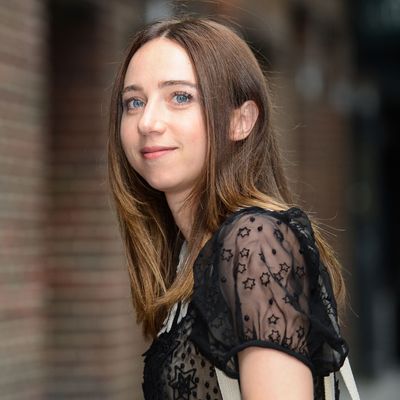
This month, Zoe Kazan — who, this year, has already starred in The Big Sick with Kumail Nanjiani and made an appearance on HBO’s The Deuce — accomplished a personal first: She wrote a well-received post-apocalyptic play called After the Blast, starring Cristin Milioti and, not incidentally, a surprisingly adorable, partially fur-covered robot named Arthur. The play follows a young woman named Anna struggling with depression and trying to have a child with her husband, Oliver, while both are living underground in the wake of an unnamed global catastrophe. For Kazan — who’s previously written the plays We Live Here and Trudy and Max in Love, as well as the fantastical screenplay Ruby Sparks — After the Blast is her first foray into dystopia and robotic co-stars. Adam Sternbergh spoke to her about her induction into the dreaded genre-writer category, becoming a late-life Stephen King convert, and one of her unexpected favorite books of the year.
So, you’re a science-fiction writer now. Are you ready to put that on your business card?
You know, growing up, I was a real reading snob. I didn’t read a ton of genre fiction. About seven years ago, right after I wrote Ruby Sparks, I went through a pretty bad little bout of depression and I really wanted to read — but I wanted to read the way I read when I was a kid: walking down halls, in the bath, in such a hungry way. Somehow, the English major in me had killed that.
So what did you read?
I read Stephen King’s Carrie, looking for a little escape. Frankly, I’d always thought Stephen King was airport reading and I was proven so wrong. I was shocked at what an amazing book it is. I think it’s a great piece of literature. And that opened all these doors in terms of what I read now. I read much more widely. Have you read My Favorite Thing Is Monsters?
I haven’t.
It’s amazing! You have to read it. It’s a graphic novel. It’s sort of a murder mystery and about this girl’s obsession with monster movies and it’s definitely one of the best books I’ve read this year. But at some point, over the past four or five years, I started reading a lot more science fiction. And horror.
So naturally you decided to write a post-apocalyptic play with a robot in it.
The idea originated about four years ago with me wanting to put a robot onstage. I read this article about things you can buy in New Jersey, and one of them is robots for conventions that have speakers in them and hand out pamphlets. I looked them up online and they kind of look like Muppets. And I thought, I could put that object onstage. Then I thought, If I did do that, what would I do with it?
What kind of a design process was it to come to the final robot? The choice of plush fur on the robot is kind of genius in terms of making Arthur lovable.
The unsung hero in all of this is the props designer, Noah Mease. He’s a writer himself, and he did a tremendous amount of thinking about future worlds and what we would have and what we won’t have. He came up with the plushiness of the robot. He said, “If this object’s true function is to be a companion — it doesn’t need to be able to do anything, it just has to be something people want to have around.”
But why write a play about this dystopic future? Why not write, say, an episode of Black Mirror?
The idea of putting this object onstage made it feel to me like this should specifically be told in the theater. Then I became fixated on how the plot should interact with that object, and how to create an anthropomorphic, empathetic reaction in the audience over time. But the biggest surprise to me are the ways in which the play is very personal and very emotional. When I was finished with the first draft, I sat back and I could see what I had written — and that’s when I thought, “Oh, I wrote something really personal.” That really snuck up on me.




